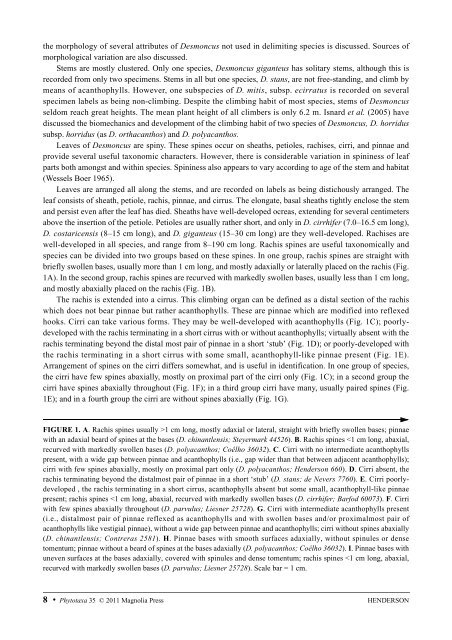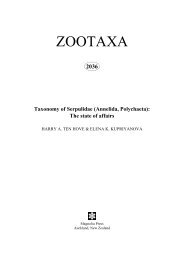Create successful ePaper yourself
Turn your PDF publications into a flip-book with our unique Google optimized e-Paper software.
the morphology of several attributes of Desmoncus not used in delimiting species is discussed. Sources of<br />
morphological variation are also discussed.<br />
Stems are mostly clustered. Only one species, Desmoncus giganteus has solitary stems, although this is<br />
recorded from only two specimens. Stems in all but one species, D. stans, are not free-standing, and climb by<br />
means of acanthophylls. However, one subspecies of D. mitis, subsp. ecirratus is recorded on several<br />
specimen labels as being non-climbing. Despite the climbing habit of most species, stems of Desmoncus<br />
seldom reach great heights. The mean plant height of all climbers is only 6.2 m. Isnard et al. (2005) have<br />
discussed the biomechanics and development of the climbing habit of two species of Desmoncus, D. horridus<br />
subsp. horridus (as D. orthacanthos) and D. polyacanthos.<br />
Leaves of Desmoncus are spiny. These spines occur on sheaths, petioles, rachises, cirri, and pinnae and<br />
provide several useful taxonomic characters. However, there is considerable variation in spininess of leaf<br />
parts both amongst and within species. Spininess also appears to vary according to age of the stem and habitat<br />
(Wessels Boer 1965).<br />
Leaves are arranged all along the stems, and are recorded on labels as being distichously arranged. The<br />
leaf consists of sheath, petiole, rachis, pinnae, and cirrus. The elongate, basal sheaths tightly enclose the stem<br />
and persist even after the leaf has died. Sheaths have well-developed ocreas, extending for several centimeters<br />
above the insertion of the petiole. Petioles are usually rather short, and only in D. cirrhifer (7.0–16.5 cm long),<br />
D. costaricensis (8–15 cm long), and D. giganteus (15–30 cm long) are they well-developed. Rachises are<br />
well-developed in all species, and range from 8–190 cm long. Rachis spines are useful taxonomically and<br />
species can be divided into two groups based on these spines. In one group, rachis spines are straight with<br />
briefly swollen bases, usually more than 1 cm long, and mostly adaxially or laterally placed on the rachis (Fig.<br />
1A). In the second group, rachis spines are recurved with markedly swollen bases, usually less than 1 cm long,<br />
and mostly abaxially placed on the rachis (Fig. 1B).<br />
The rachis is extended into a cirrus. This climbing organ can be defined as a distal section of the rachis<br />
which does not bear pinnae but rather acanthophylls. These are pinnae which are modified into reflexed<br />
hooks. Cirri can take various forms. They may be well-developed with acanthophylls (Fig. 1C); poorlydeveloped<br />
with the rachis terminating in a short cirrus with or without acanthophylls; virtually absent with the<br />
rachis terminating beyond the distal most pair of pinnae in a short ‘stub’ (Fig. 1D); or poorly-developed with<br />
the rachis terminating in a short cirrus with some small, acanthophyll-like pinnae present (Fig. 1E).<br />
Arrangement of spines on the cirri differs somewhat, and is useful in identification. In one group of species,<br />
the cirri have few spines abaxially, mostly on proximal part of the cirri only (Fig. 1C); in a second group the<br />
cirri have spines abaxially throughout (Fig. 1F); in a third group cirri have many, usually paired spines (Fig.<br />
1E); and in a fourth group the cirri are without spines abaxially (Fig. 1G).<br />
FIGURE 1. A. Rachis spines usually >1 cm long, mostly adaxial or lateral, straight with briefly swollen bases; pinnae<br />
with an adaxial beard of spines at the bases (D. chinantlensis; Steyermark 44526). B. Rachis spines
















